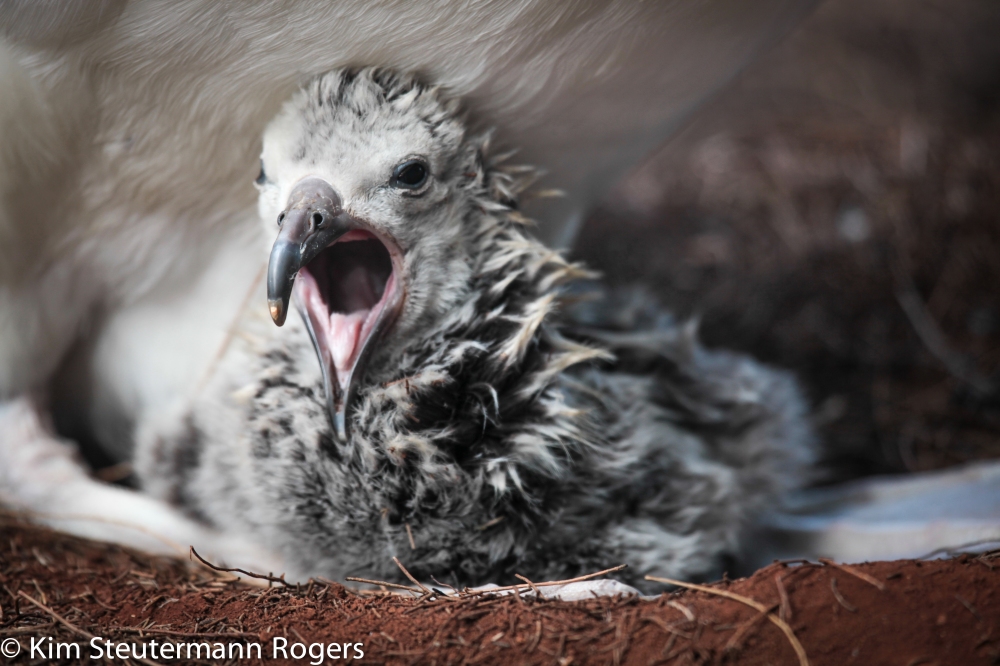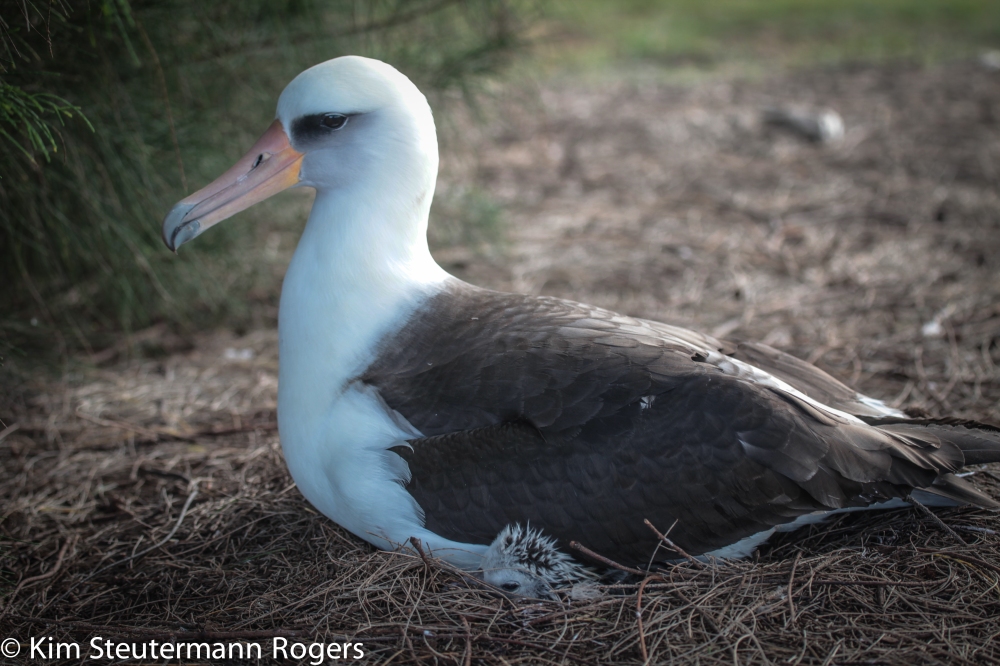Yesterday, on Groundhog’s Day, a rodent named Punxsutawney Phil emerged from his burrow at Gobbler’s Knob in Pennsylvania, where temperatures hovered around 22 degrees, and did not see his shadow, suggesting, according to local legend, that an early spring is forthcoming. In New York, Staten Island Chuck concurred. In Georgia, General Beau Lee, too. And in Canada, a groundhog named Shubenacadie Sam verified Phil’s prediction. It’s agreed: Daffodils and tulips will sprout their heads early this year.
 Further west, on a tropical island in the middle of the Pacific, a Laysan albatross chick emerged from the burrow of its parent’s protective body. And yawned.
Further west, on a tropical island in the middle of the Pacific, a Laysan albatross chick emerged from the burrow of its parent’s protective body. And yawned.
There were shadows, and there were none. Then, there were shadows again. That’s how the weather goes in Hawai‘i. Winter brings periods of rain showers followed by sunshine. Also, if you’ve been following my Facebook feed, you’ll know winter also brings whales and rainbows.
 If there were messages or predictions that an albatross’s shadow might bring in Hawai‘i, it would revolve around food. Like maybe if the chick saw its shadow, the seas would be scarce. It didn’t see its shadow, fish and squid would be plentiful. All this would predict how far and wide a chick’s parents would need to forage. Often, it’s tens of thousands of miles.
If there were messages or predictions that an albatross’s shadow might bring in Hawai‘i, it would revolve around food. Like maybe if the chick saw its shadow, the seas would be scarce. It didn’t see its shadow, fish and squid would be plentiful. All this would predict how far and wide a chick’s parents would need to forage. Often, it’s tens of thousands of miles.
We have a saying around Hawai‘i that you’ll often see on bumper stickers. It goes: Try wait.
The Pidgin phrase has many meanings. In traffic, it might mean to slow down or stop tailgating. Or, let’s say you’re in a conversation with someone and need to pause to do something else—like put out a fire on the stove or give a choking person across the restaurant the Heimlich Maneuver—you might lift a finger and say, “Try wait, eh.” In a store, you might hear, “Get plenny customahs. Try wait.” And that would translate to, “I’ll be with you as soon as I finish with this customer.” Then, there’s the Catholic Charities abstinence program aimed at teens, called, Try Wait! No translation necessary.
Whether an albatross chick sees its shadow or not, “Try wait” is what the species is built to do.
When a female lays an egg in early December, she and her mate each take weeks-long shifts incubating it. They wait up to 65 days for the egg to alchemize into a fuzzy chick. Then, the chick spends another five-plus months waiting for periodic visits from its parents to deliver protein-packed smoothies of fish and squid oil as the chick’s wings go from stubs to six-and-a-half-feet in length, wingtip to wingtip.
I believe nature has much to teach us. For albatross, one of their many lessons is patience.
 Yesterday, as I surveyed a colony of Laysan albatross, identifying adults by their leg bands and noting whether bits of eggshell were sprinkled outside nests—my clues to take a closer look for fuzzy chicks underneath sitting parents—I was approached by a man. He’d spent a few minutes studying the birds, leaning quietly on his walking sticks.
Yesterday, as I surveyed a colony of Laysan albatross, identifying adults by their leg bands and noting whether bits of eggshell were sprinkled outside nests—my clues to take a closer look for fuzzy chicks underneath sitting parents—I was approached by a man. He’d spent a few minutes studying the birds, leaning quietly on his walking sticks.
“Are they always so peaceful,” he asked me.
I observed the colony as two non-nesters unfolded their origami wings and let the wind lift them into the air. The rest of the birds were nesters, sitting quietly on their chicks. I realized the man had tapped into the emotion I never fail to feel whenever I spend time among albatross. For me, it’s like an infusion of meditation.
“Yes,” I said. No shadows required.

So true!
LikeLike
That was beautiful, Kim..
LikeLike
Mahalo nui.
LikeLike
Nature at it’s best!
LikeLike
Agreed!
LikeLike
Gorgeous! Made me feel peaceful just to read this.
LikeLike
Ommmmmmm!
LikeLike
Love the connections you point out and the photos are spectacular!
LikeLike
Mahalo plenny!
LikeLike
Wonderful! Mahalo nui loa
LikeLike